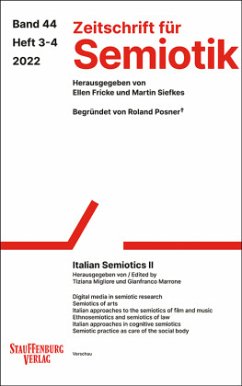Aus dem Inhalt:Francesco Mangiapane: Digital Media in Semiotic Research in ItalySummary. This essay retraces how the internet and the digital media in general have been approached by semiotics in Italian studies. The essay begins by noting that many of the issues arising from the advent of the digital communication, such as the dialectics among "apocalyptic and integrated", the role attributed to technology in the process of the transformation of societies and the debate over the models of knowledge (eg. Eco's remarks on the tree as a metaphor of knowledge as opposed to the labyrinth or on the limits of the interpretation) were discussed and already on the agenda of the discipline several years before the diffusion of the internet. Then, it deals with the first studies on digital artefacts, mostly focused on the communicative aspects of websites and their interfaces, as well as on the novelty represented by the "short texts" disseminated in new media (banners, clips, gifs etc.). After that, it shows how, starting from the studies of Floch ([1995] 2000), the discourse over digital media matures and produces a vast series of essays covering the socialisation processes on the web and in social networks. In such a scenario, the web is less a "topic" to be examined than an environment to be investigated in search of specific forms of interactions occurring in specific discourses (politics, marketing, food etc.).Zusammenfassung. Dieser Aufsatz zeichnet nach, wie das Internet und die digitalen Medien im Allgemeinen von der italienischen Semiotik behandelt wurden und werden. Ausgangspunkt ist die Feststellung, dass viele der Probleme, die sich aus dem Aufkommen der digitalen Kommunikation ergeben - wie beispielsweise die Dialektik zwischen "apokalyptisch" und "integriert", die der Technologie zugeschriebene Rolle im Transformationsprozess der Gesellschaften und die Debatte über verschiedene Wissensmodelle (z.B. Ecos Bemerkungen zum Baum als Metapher des Wissens im Gegensatz zum Labyrinth oder zu den Grenzen der Interpretation) - bereits mehrere Jahre vor der Verbreitung des Internets in der Disziplin diskutiert wurden. Der folgende Abschnitt widmet sich insbesondere den ersten Studien zu digitalen Artefakten. Diese konzentrierten sich hauptsächlich auf die kommunikativen Aspekte von Websites und ihren Schnittstellen sowie die Verbreitung von "Kurztexten" in neuen Medien (Banner, Clips, GIFs usw.), die mit hoher Innovationskraft einhergingen. Nachfolgend wird gezeigt, wie sich der Diskurs über digitale Medien ausgehend von den Studien von Floch ([1995] 2000) entwickelt hat und eine Vielzahl von Aufsätzen hervorgebracht hat, die primär die Sozialisierungsprozesse im Web und in sozialen Netzwerken behandeln. Die Sichtweise auf das Web entwickelt sich also vom "Thema", das untersucht werden soll, zu einer Umgebung, die nach spezifischen Interaktionsformen in verschiedenen Diskursen (Politik, Marketing, Lebensmittel usw.) untersucht werden soll.Francesca Polacci: Semiotics of Arts: A Historical SurveySummary. The essay identifies the founding moment of Italian semiotics of the image in Omar Calabrese's book La macchina della pittura. Pratiche teoriche della rappresentazione figurativa tra Rinascimento e Barocco [The Painting System. Theoretical Practices of Figurative Representation between Renaissance and Baroque], published in 1985 (Calabrese 1985a). The book is a meeting point between semiotic methodology applied to the visual and studies in the field of French art theory. In our work, the conceptual and thematic axes focused on by the book are explored alongside the most recent developments in the Italian semiotics of art. The theoretical cornerstones underpinning the discipline include Greimas's essay Figurative Semiotics and the Semiotics of the Plastic Arts (1984), the concept of art as a "theoretical object", the concept of visual enunciation and the centrality of the passions in images.Zusammenfassung. Der Aufsatz iden

